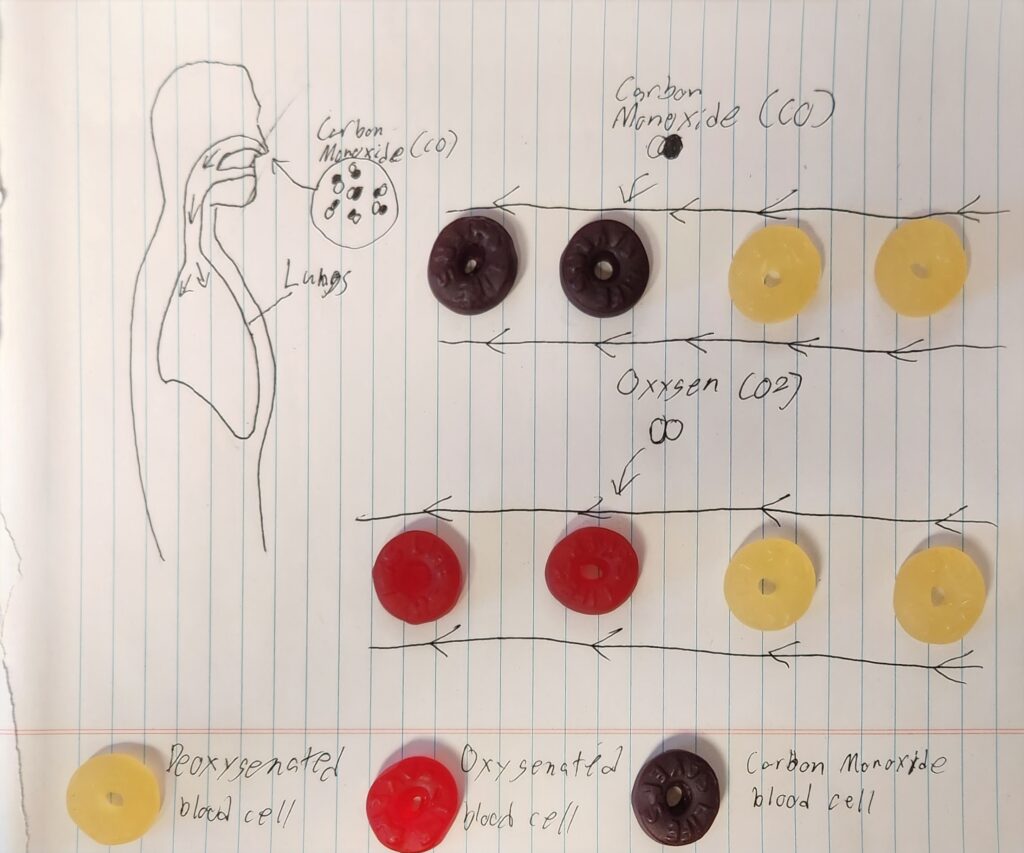In my STEAM project, I am illustrating the process in which carbon monoxide interrupts the oxygenation of red blood cells. The medium I am using is a combination of gummy candy and drawings. Carbon monoxide (CO) is a toxic gas that can interfere with the body’s ability to get oxygen from the air. When we breathe in oxygen, it travels to the lungs and enters the bloodstream. The red blood cells (RBCs) in the blood carry oxygen to all parts of the body. However, carbon monoxide can bind to the hemoglobin molecules in the RBCs, which can interfere with oxygen transport and cause a wide range of health problems.
Hemoglobin is a protein found in red blood cells that binds to oxygen and carries it to the body’s tissues. It consists of four subunits, each of which contains a heme group with an iron atom at its center. When oxygen binds to the iron atom, the heme group undergoes a conformational change, which allows it to carry oxygen. However, when carbon monoxide is present in the blood, it can compete with oxygen for binding sites on the heme group.
Carbon monoxide is a small molecule that is attracted to the iron atom in the heme group. Once it binds to the iron atom, it forms a stable complex known as carboxyhemoglobin (COHb). This complex cannot carry oxygen, which means that the RBCs cannot deliver oxygen to the body’s tissues. Instead, the COHb complex circulates in the bloodstream, effectively blocking the transportation of oxygen. The effects of carbon monoxide poisoning can vary depending on the concentration and duration of exposure. At low levels of carbon monoxide, symptoms may include headaches, dizziness, nausea, and fatigue. At higher levels of carbon monoxide, symptoms can include confusion, loss of consciousness, seizures, and even death. In addition to its effects on hemoglobin, carbon monoxide can also damage the cells lining the blood vessels. This can cause inflammation and swelling, further impeding the healthy flow of oxygen to the body’s tissues.
The body has a limited ability to remove carbon monoxide from the bloodstream. The majority of carbon monoxide is eliminated through the lungs, where it is exhaled as carbon dioxide. However, the elimination process can be slow, particularly at high concentrations of carbon monoxide. Treatment for carbon monoxide poisoning typically involves removing the individual from the source of exposure and administering oxygen therapy. Oxygen can help displace carbon monoxide from the heme groups in the RBCs, allowing them to resume their usual function as oxygen transport. In severe cases, hyperbaric oxygen therapy may be used, which involves administering oxygen in a high-pressure environment to increase the amount of oxygen that can dissolve in the blood.
In conclusion, carbon monoxide poisoning is a serious, and sometimes fatal, medical emergency that can disrupt the oxygenation process in red blood cells. The gas can bind to the heme groups in hemoglobin, forming a stable complex that cannot release oxygen. This can lead to severe tissue damage and even death. Early recognition and treatment of carbon monoxide poisoning are essential to prevent long-term complications and improve outcomes. It’s important to be aware of the potential sources of carbon monoxide, such as faulty gas appliances, generators, and car exhaust fumes, and take precautions to protect yourself and your family from exposure.


Benjamin used lifesavers to illustrate how carbon monoxide interrupts the process of oxygenation. He used white ones to represent deoxygenated blood cells, red to represent oxygenated blood cells, and black to represent carbon monoxide blood cells. In his diagram, the carbon monoxide cells replace the red oxygenated blood cells leaving only white blood cells. This shows how carbon monoxide works to replace/block the body’s ability to get oxygen, this is what is seen in carbon monoxide poisoning. Hemoglobin, a protein, plays an essential component in oxygenation. It binds oxygen and carries it to the body’s tissues; it does this because it contains four units each carrying a heme group and an iron atom. When oxygen binds to the iron atom the heme group changes allowing it to carry oxygen. However, when carbon monoxide is present it competes with oxygen for binding sites with the iron atom. When carbon monoxide binds to the iron atom it creates a stable complex called carboxyhemoglobin (COHb). The body can remove carbon monoxide from the bloodstream however it is a slow process especially when there is a high concentration of it in the blood. Your body works by expelling carbon monoxide through the lungs, into carbon dioxide however this process can be sped up using oxygen therapy, supplementing the oxygen that was lost. Hyperbaric oxygen therapy, administering oxygen in a high-pressure environment can also be used. Symptoms of carbon monoxide poisoning include dizziness, fatigue, nausea, and headaches. At higher levels, symptoms like seizures, confusion, loss of consciousness, and even death can occur.